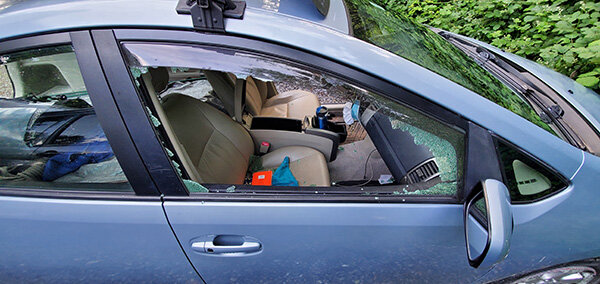 The aftermath of a break-in at the parking lot of the Index Town Walls.
The aftermath of a break-in at the parking lot of the Index Town Walls.It was weird. There was a single rock shoe lying on the ground behind my car.
I approached and realized what I was seeing. My rear window was smashed. And three small backpacks (each with rock shoes and chalk in them) were missing. Presumably, there was only one rock shoe in one of the packs, as the other was on the ground.
Crap!
I’d suffered a trailhead break-in.
As someone who has spent the last 30 years climbing, backpacking, skiing and hiking pretty much everywhere, I’d seen it before. And indeed, as the manager of a guide service with 60 employees that spend significant time parked at trailheads, I’m intimately aware of this “wilderness” hazard.
As a result of this incident though, I decided to revisit my trailhead theft prevention and response strategies. I spoke to several backcountry users about their tactics and have compiled them here.
Insurance
Before ever heading out to the trailhead, make sure that the items within your car are insured under a homeowner’s or renter’s insurance policy. Auto policies seldom cover the theft of personal items.
If you’re traveling and use a rental car, consider purchasing a trip insurance policy that covers theft for the duration of your trip.
In addition to an insurance policy, it’s important to know what’s in your car. It’s especially important to have an inventory if you’re on a road trip with expensive outdoor equipment. A picture of vehicle contents before departure could be worth thousands of dollars. And indeed, if you have high value items, serial numbers can be very helpful, especially if items are being sold online after the theft.
Vehicle Positioning
Visibility decreases the likelihood of a smash and grab. If the thief can be seen, they can be caught.
Avoid parking next to large vehicles (like Sprinter vans) that could screen a thief from view. Similarly, the more secluded the part of the lot is where you intend to park, the more likely it’s a target. A high volume of back-and-forth foot traffic near your vehicle makes it a less desirable target.
 An American Alpine Institute van at the Eldorado Trailhead on Cascade River Road in the summer of 2022. Will Gordon photo
An American Alpine Institute van at the Eldorado Trailhead on Cascade River Road in the summer of 2022. Will Gordon photoDon’t back your car into a position where someone could hide behind it and break the rear window. This is a common and expensive entry point for thieves.
Car Alarms
There’s some debate about how effective a car alarm might be. Most break-ins are smash and grab jobs. So while an alarm may decrease the number of valuables taken, it may not change the thief’s overall strategy.
Cars with obvious blinking alarm lights on the dashboard — or even dummy alarm lights — may provide more of a deterrent than the alarm itself.
Valuables
At high theft areas in our region, there are commonly signs that say, “Lock your car and take your valuables.” But what if you have to leave something valuable in your car, or you’re on a road trip?
Trailhead break-ins are often crimes of opportunity. And if it’s clear that there’s an opportunity to get something, it’s more likely that a thief will break in. From that perspective, it’s important to make sure that there are limited visible opportunities in your car. Don’t leave bags, purses or backpacks in sight.
The combination of a windshield shade and tinted windows decrease interior visibility. If you don’t have tinted windows, an auto detailer can install them for $200 to $800 depending on the type of vehicle. If you have a retractable security shield in the trunk, engage that and place any bags or other desirable items underneath it.
RocketBox rooftop cargo carriers are seldom theft targets because they are often empty and can be difficult to break into. If you have a box, consider leaving valuables inside.
On road trips, some people hide valuables inside the car. The glove box is not a hiding place, but a target, as some people keep wallets, spare keys or weapons in them. If you elect to leave a valuable in the car — like a wallet or a laptop — it should be well hidden, so that it is easily missed by a smash and grab attack.
Post Break-In Procedures
Before doing anything else, be sure to take pictures of the scene and make notes about the likely time of the break-in. In addition to that, look around the parking lot to ensure that nothing was dumped from your vehicle.
It is common for thieves to riffle through bags while they’re on the road. When finished, they often throw things out the window. As such, it’s important to search both sides of the road near your trailhead.
Once in service, make a police report. This is important for two reasons. First, you want the perpetrator to be caught; there might be something in the report that helps law enforcement find the thief. This is where serial numbers can be incredibly helpful. And second, insurance companies often use police reports to ensure that theft claims are legitimate. If you make a claim without a report, it’s possible that it will be rejected.
The reality is that most avid outdoors people suffer the indignity of a trailhead break-in once every five to 10 years. But perhaps by following some of these tips, a few of you will be able to stretch that out, or at least avoid some of the financial fallout following one of these incidents… x
Jason D. Martin is the executive director at the American Alpine Institute, a mountain guide and a widely published outdoor writer. He lives in Bellingham with his wife and two kids.